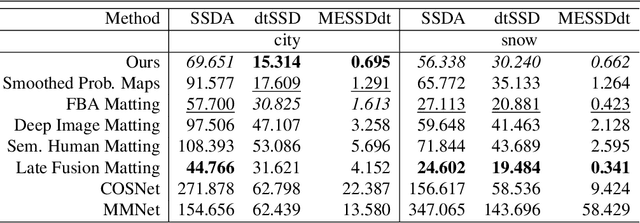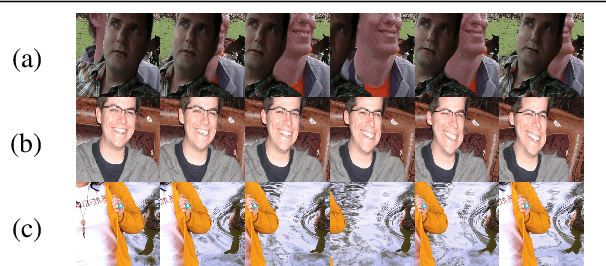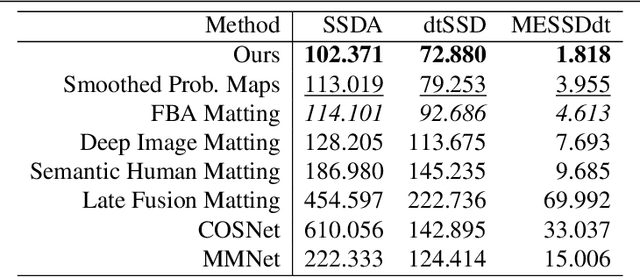Andrey Moskalenko
RClicks: Realistic Click Simulation for Benchmarking Interactive Segmentation
Oct 15, 2024Abstract:The emergence of Segment Anything (SAM) sparked research interest in the field of interactive segmentation, especially in the context of image editing tasks and speeding up data annotation. Unlike common semantic segmentation, interactive segmentation methods allow users to directly influence their output through prompts (e.g. clicks). However, click patterns in real-world interactive segmentation scenarios remain largely unexplored. Most methods rely on the assumption that users would click in the center of the largest erroneous area. Nevertheless, recent studies show that this is not always the case. Thus, methods may have poor performance in real-world deployment despite high metrics in a baseline benchmark. To accurately simulate real-user clicks, we conducted a large crowdsourcing study of click patterns in an interactive segmentation scenario and collected 475K real-user clicks. Drawing on ideas from saliency tasks, we develop a clickability model that enables sampling clicks, which closely resemble actual user inputs. Using our model and dataset, we propose RClicks benchmark for a comprehensive comparison of existing interactive segmentation methods on realistic clicks. Specifically, we evaluate not only the average quality of methods, but also the robustness w.r.t. click patterns. According to our benchmark, in real-world usage interactive segmentation models may perform worse than it has been reported in the baseline benchmark, and most of the methods are not robust. We believe that RClicks is a significant step towards creating interactive segmentation methods that provide the best user experience in real-world cases.
Bridging the Gap Between Saliency Prediction and Image Quality Assessment
May 08, 2024Abstract:Over the past few years, deep neural models have made considerable advances in image quality assessment (IQA). However, the underlying reasons for their success remain unclear, owing to the complex nature of deep neural networks. IQA aims to describe how the human visual system (HVS) works and to create its efficient approximations. On the other hand, Saliency Prediction task aims to emulate HVS via determining areas of visual interest. Thus, we believe that saliency plays a crucial role in human perception. In this work, we conduct an empirical study that reveals the relation between IQA and Saliency Prediction tasks, demonstrating that the former incorporates knowledge of the latter. Moreover, we introduce a novel SACID dataset of saliency-aware compressed images and conduct a large-scale comparison of classic and neural-based IQA methods. All supplementary code and data will be available at the time of publication.
TETRIS: Towards Exploring the Robustness of Interactive Segmentation
Feb 09, 2024Abstract:Interactive segmentation methods rely on user inputs to iteratively update the selection mask. A click specifying the object of interest is arguably the most simple and intuitive interaction type, and thereby the most common choice for interactive segmentation. However, user clicking patterns in the interactive segmentation context remain unexplored. Accordingly, interactive segmentation evaluation strategies rely more on intuition and common sense rather than empirical studies (e.g., assuming that users tend to click in the center of the area with the largest error). In this work, we conduct a real user study to investigate real user clicking patterns. This study reveals that the intuitive assumption made in the common evaluation strategy may not hold. As a result, interactive segmentation models may show high scores in the standard benchmarks, but it does not imply that they would perform well in a real world scenario. To assess the applicability of interactive segmentation methods, we propose a novel evaluation strategy providing a more comprehensive analysis of a model's performance. To this end, we propose a methodology for finding extreme user inputs by a direct optimization in a white-box adversarial attack on the interactive segmentation model. Based on the performance with such adversarial user inputs, we assess the robustness of interactive segmentation models w.r.t click positions. Besides, we introduce a novel benchmark for measuring the robustness of interactive segmentation, and report the results of an extensive evaluation of dozens of models.
Temporally Coherent Person Matting Trained on Fake-Motion Dataset
Sep 10, 2021



Abstract:We propose a novel neural-network-based method to perform matting of videos depicting people that does not require additional user input such as trimaps. Our architecture achieves temporal stability of the resulting alpha mattes by using motion-estimation-based smoothing of image-segmentation algorithm outputs, combined with convolutional-LSTM modules on U-Net skip connections. We also propose a fake-motion algorithm that generates training clips for the video-matting network given photos with ground-truth alpha mattes and background videos. We apply random motion to photos and their mattes to simulate movement one would find in real videos and composite the result with the background clips. It lets us train a deep neural network operating on videos in an absence of a large annotated video dataset and provides ground-truth training-clip foreground optical flow for use in loss functions.
Deep Two-Stage High-Resolution Image Inpainting
Apr 27, 2021



Abstract:In recent years, the field of image inpainting has developed rapidly, learning based approaches show impressive results in the task of filling missing parts in an image. But most deep methods are strongly tied to the resolution of the images on which they were trained. A slight resolution increase leads to serious artifacts and unsatisfactory filling quality. These methods are therefore unsuitable for interactive image processing. In this article, we propose a method that solves the problem of inpainting arbitrary-size images. We also describe a way to better restore texture fragments in the filled area. For this, we propose to use information from neighboring pixels by shifting the original image in four directions. Moreover, this approach can work with existing inpainting models, making them almost resolution independent without the need for retraining. We also created a GIMP plugin that implements our technique. The plugin, code, and model weights are available at https://github.com/a-mos/High_Resolution_Image_Inpainting.
 Add to Chrome
Add to Chrome Add to Firefox
Add to Firefox Add to Edge
Add to Edge